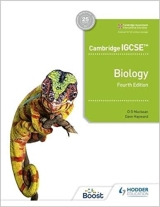Chapter 40. Development of biological ideas
Page355
1. It was not until 1660 that a microscope was developed which was powerful enough to see the capillaries connecting arteries to veins.
2. Harvey’s ideas were rejected simply because they contradicted the work of a 2nd century physician, Galen.
3. a The current theory is that, in the right conditions over the past 400 million years or more, the bodies or parts of bodies of animals and plants became preserved in sedimentary rocks or other suitable deposits.
b It was not the origin of fossils which was disputed but rather the interpretation of their significance in terms of evolution or creation. The question is misleading.
4. The advantage of the Linnaean system of naming organisms is that it attempts to put them into related groups in a way that leads to a natural classificatory system. Also, giving organisms ‘Latin’ names meant that everyone would know exactly which organism was being described, rather than having many different names for the same organism.
5. a Mendel concluded that:
(i) characteristics can be inherited,
(ii) one characteristic could be dominant over another,
(iii) with a pair of contrasting characteristics only one can appear in the organism,
(iv) a recessive characteristic which is not expressed in the first generation, can still appear in
the second generation. It does not ‘disappear’,
(v) the characteristics are transmitted by the gametes.
b Mendel published his findings but in a local journal that was not widely circulated.
6. a Lamarck’s theory supposed that variations which developed during the life-time of an organism could be inherited. Darwin thought that the variations developed by chance and were heritable.
b They both believed that beneficial characteristics could be inherited and lead to the development of more successful organisms. They thought that the process took place by very small changes and was continuous.
7. The discovery of mutations showed one way by which variations could arise and be inherited.
8. a It was shown by experiment that the appearance of maggots in meat was not spontaneous generation but the product of blowflies laying eggs in the meat. The eggs hatched into maggots.
b Pasteur’s experiments showed that if you prevented free access to air, micro-organisms would not appear in boiled meat broth.
9. Pasteur controlled a disease of silkworms by removing all dead and infected individuals so that the disease could not spread to the healthy silkworms. Foot and mouth disease in cattle is similarly controlled by destroying infected individuals but in many cases the whole herd is slaughtered to prevent the disease reaching other farms.
10. Chargaff discovered that in a sample of DNA the number of adenines was always equal to the numbers of thymines, and also that cytosines and guanines were equally matched. This suggested that these bases were paired in the DNA molecule.
11. Maurice Wilkins and Rosalind Franklin carried out X-ray analysis of DNA which suggested the structure of the molecule. Crick and Watson used these results in constructing their model of DNA. |
Downloads
Download the answers in PDF format below
Section 1, Chapters 1-5
Section 2, Chapters 6-9
Section 3, Chapters 10-12
Section 3, Chapters 13-17
Section 3, Chapters 18-20
Section 4, Chapters 21-24
Section 5, Chapters 25-27
Section 5, Chapters 28-29
Section 6, Chapters 30-34
Section 6, Chapters 35-37
Section 7, Chapters 38-39
Section 8, Chapters 40-41
|
